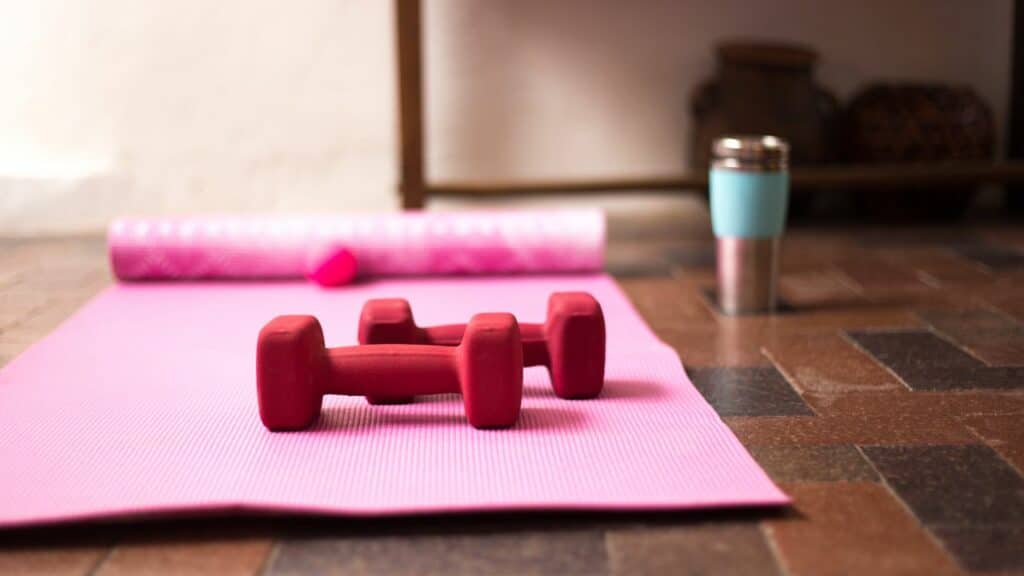
They seem like an unlikely pair—yoga and weights—but let me tell you, it can take your yoga practice to the next level. From building strength and improving bone density to enhancing balance and stability, the benefits of using weights with yoga are endless. In this blog post, I’ll share with you why people of all ages and fitness levels can benefit from adding weights to their yoga practice. So grab your yoga mat and some weights, and let’s dive.
Benefits of Using Weights with Yoga
By combining yoga and strength training, you can enjoy the benefits of both forms of exercise. Here are some of the reasons why you should give it a go:
- Enhances Strength Training: Adding weights to your yoga practice can help you to build strength and tone your muscles in ways that traditional yoga poses may not be able to accomplish on their own.
- Builds Stronger Bones: Using weights can also help to build stronger bones by placing stress on them and stimulating the production of new bone tissue.
- Boosts Metabolism: When you incorporate weights into your yoga practice, you can create a high-intensity workout that will boost your metabolism and help you burn more calories.
- Improves Balance and Stability: Holding weights during yoga poses can improve your balance and stability by forcing you to engage your core and other stabilizing muscles.
- Increases Flexibility and Mobility: Stiff joints and decreased flexibility are common issues among older adults. Incorporating weights into yoga can help to increase flexibility and mobility, making it easier to perform daily tasks and reducing the risk of injury.
- Challenges Your Mind and Body: Incorporating weights into your yoga practice can make your routine more challenging and help you to push past mental and physical barriers.
- Improves Active Recovery: Traditional yoga is a great way to recover after a tough workout, but by adding a little weight to your routine you increase blood circulation, promote nutrient delivery to muscles, and expedite the repair process.
- Variety: Using weights can add variety to your yoga practice, making it more interesting and engaging.
Yoga with Weights Workouts
So, let’s begin. We’ve put together a collection of workouts that perfectly merge yoga and weights just for you. Let’s try them out!
Chair Pose with Overhead Press
Standing with your feet hip-width apart, hold a weight in each hand at shoulder height. As you inhale, bend your knees and lower into a chair pose. As you exhale, press the weights up overhead, extending your arms fully. Hold for a few breaths, then lower the weights and stand up. Repeat this 10-15 times.
Warrior II with Lateral Raise
Hold a weight in each hand at your sides, with your palms facing inward. As you move into Warrior II, lift the weights out to the sides, keeping your arms straight and parallel to the ground. Hold for 10 to 15 seconds on both sides. Lower the weights back down and repeat for several repetitions. Repeat this 10 times.
High Lunge Pose with Bicep Curl
For this pose, hold a weight in each hand at your sides with your palms facing forward. As you inhale, step forward into a high lunge pose while lifting the weights up toward your shoulders, keeping your elbows close to your body. Exhale and step back into the starting position while also lowering the weights. Alternate legs and do 20 times total.
Plank Pose with Row
Begin in a plank position, with your shoulders directly over your wrists and your body in a straight line. Hold a dumbbell in each hand. As you inhale, lift your right elbow up towards the ceiling, squeezing your shoulder blades together. As you exhale, lower the weight back down. Repeat on the other arm and do 30 reps total.
Bridge Pose with Chest Press
Start on your back with knees bent and holding weights by your chest. On an inhale, come into the bridge pose, lifting your pelvis towards the ceiling while pressing the weights upward. Be sure to maintain a strong bridge position the entire time. On an exhale, lower back down into your starting position. That is one rep. Repeat this 20 times. You could modify this by lifting the weights multiple times while holding the bridge pose.
Horse Pose with Low Row
Holding dumbells in front of you (palms facing inward), get into a wide stance with toes pointing outward. As you inhale, bend your knees and sink down as low as you can into a horse stance (or goddess pose). As you exhale, push upward through your feet to a standing position while pulling the weights up towards your chest, keeping your elbows close to your body and squeezing your shoulder blades together. Inhale as you lower the weights back down. Repeat this 20 times.
Tree Pose with Shoulder Press
Hold a dumbbell in each hand, with your palms facing forward. Starting in a standing position, shift your weight onto your left foot and bring your right foot to your inner left thigh (or calf). As you inhale, lift the weights up to shoulder height. As you exhale, press them up overhead. Hold for several breaths, then lower the weights and switch legs. Do this 10 times. You can also do multiple shoulder presses while on each leg.
Warrior III with Reverse Fly
Begin standing straight, then shift your weight onto your left foot and hinge forward at the hips, lifting your right leg off the ground. Hold a dumbbell in each hand, with your palms facing each other. As you inhale, raise the weights out to the sides, parallel to the floor. As you exhale, lower them back down. Repeat this 15 to 20 times.
Choosing the Right Weights for Yoga?
When selecting the right weights for yoga, it’s important to choose a weight that will challenge you without being too heavy. Start by selecting a weight that is light enough so that you can do all of the movements with good form (2-5 lbs dumbbells). As you become more comfortable, increase the weight until it becomes challenging but still allows you to maintain proper form.
The amount of weight you use also depends on the type of yoga you are practicing. For example, if you are doing a more restorative type of yoga practice, lighter weights may be appropriate. However, for an active practice like vinyasa or yoga sculpt, heavier weights may be needed for an effective workout.
We’re familiar with hand weights and dumbells, but ankle weight can also be used in your yoga routine. Ankle weights are great for adding resistance without compromising form and can be used in many yoga postures, especially inversion poses. Try using ankle weights with a warrior III or reverse plank with leg lift.
Ultimately, the most important thing is to listen to your body and choose a weight that works for you. Start light and gradually increase the resistance as you become more comfortable with the movements.
Tips for Using Weights with Yoga
When adding weights to your yoga practice, it’s important to remember a few key tips:
- Create the space: To really get the most out of any yoga practice, take time to setup your ideal workout space. Here are some tips to build a minimalist home gym.
- Warm-up first: Start with some gentle cardio exercises like jumping jacks or jogging in place. Then, do some dynamic stretches to get your muscles ready for your yoga practice.
- Incorporate weights gradually: Beginners should start with lightweight dumbbells and a few easy yoga poses. Only add more weight and complexity as you become comfortable.
- Move slowly and with control: Don’t rush through the movements as this can lead to improper form and possible injury.
- Focus on your breath throughout the entire pose: This helps you stay centered in each movement and keep proper form.
- Keep your abdominals engaged: To help stabilize your body and protect your spine while lifting weights, be sure to engage the core.
- Focus on form: As with any exercise, proper form is critical. Make sure that you’re maintaining correct alignment and engaging the correct muscles as you incorporate weights into your yoga practice.
- Don’t overdo it: Remember to listen to your body and not push yourself too hard. If you experience pain or discomfort, stop immediately and rest.
- Join a class: Yoga sculpt classes are a great way to start combining yoga with weights. Like traditional yoga classes, yoga sculpt instructors provide prompts on proper form and positioning.



